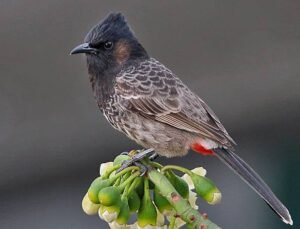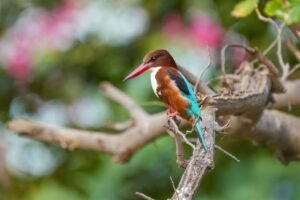Introduction to Trinket Snake (Coelognathus helena)
The Trinket Snake, scientifically known as Coelognathus helena, is a non-venomous, agile, and visually captivating snake species found in South and Southeast Asia. Admired for its vibrant patterns and curious behavior, this snake is often mistaken for a venomous species due to its defensive display. Despite this reputation, the Trinket Snake is entirely harmless to humans and plays an important role in balancing ecosystems by preying on rodents and other small vertebrates. This snake derives its common name, “Trinket,” from its colorful and glossy skin, reminiscent of ornamental jewelry. It is commonly found in forests, grasslands, and human-dominated areas where food sources like rodents are plentiful.
The Trinket Snake is an active hunter, mostly diurnal, and highly responsive to movement in its environment. Unlike many other snakes that rely heavily on ambush strategies, the Trinket Snake uses its excellent eyesight and quick reflexes to chase down prey. Though it may act aggressively when threatened, including mock strikes and body inflation, it rarely bites. This species is also popular among herpetologists and snake enthusiasts due to its striking appearance, fascinating behavior, and relatively manageable nature in captivity. Through conservation efforts and awareness, the Trinket Snake is helping to reshape public perceptions of snakes, showing that beauty and function can coexist in the animal kingdom.
Trinket Snake

Trinket Snake Species Profile
| Feature | Description |
|---|---|
| Snake Name | Trinket Snake |
| Scientific Name | Coelognathus helena |
| Wild Life Protection Act (India) | Schedule IV |
| Regional Names | Marathi: तस्कर (Taskar), तिडक्या (Tidkya – Wardha region), सडाण (Sadaṇ – Goa region), सोंगट्या (Songatya – Nashik region) Hindi: गहना सांप (Gahana Saap), अलंकृत सांप (Alankrat Samp) Gujarati: રૂપસુંદરી (Rupasundari), વાનસુંદરી (Vansundari) Malayalam: പർവത കാട്ടു പാമ്പ് (Parvatha Kaattu Paampu – for the Montane Trinket Snake subspecies) Tamil: மோதிர வளையன் (Mothira Valaiyan), மணி பாம்பு (Mani Pambu) Kannada: ಚೆಂಡುಳಿ ಹಾವು (Chenduli Havu) |
| Physical Description | Slender body, with alternating light and dark brown blotches and a distinctive eye stripe. Can grow up to 1.5–2 meters in length. |
| Habitat | Moist deciduous forests, farmlands, gardens, abandoned buildings. |
| Diet | Primarily feeds on rodents, lizards, birds, and small mammals. |
| Behaviour | Diurnal, active hunter, non-aggressive unless threatened. Shows mock-striking and puffing when disturbed. |
| Venomous or Non-Venomous | Non-Venomous |
| Venom Type | N/A (Non-venomous) |
| Venom Effects on Prey | N/A |
| Venom Effects on Humans | N/A – Harmless |
| Common or Rare Species | Common in suitable habitats |
| Life Span | 10–15 years in wild or captivity |
| Mating & Reproduction | Mating in spring; females lay 6–12 eggs; hatchlings emerge in 60–80 days. |
Introduction to Snakes and the Trinket Snake
Snakes are one of the most fascinating creatures on Earth, known for their elongated bodies, lack of limbs, and unique movement. The Trinket Snake is an exceptional example of a non-venomous snake with distinctive markings and a calm demeanor. Like other reptiles, it is cold-blooded, meaning its body temperature depends on the surrounding environment. This makes the Trinket Snake particularly active in warm conditions. Its scales not only provide protection but also help reduce friction when gliding through vegetation or rough terrain.
In the natural ecosystem, snakes like the Trinket Snake play a crucial role as both predator and prey. By feeding on rodents and small animals, they help control pest populations and maintain ecological balance. At the same time, they serve as a food source for birds of prey, larger reptiles, and mammals. This interconnectedness is essential to sustaining biodiversity.
Unfortunately, due to misinformation and fear, snakes are often killed on sight. The Trinket Snake is often mistaken for venomous species and killed unnecessarily. By spreading awareness and debunking common myths—such as all snakes are dangerous or that they chase humans—we can better protect these misunderstood creatures. Learning about the Trinket Snake helps us appreciate the intricate web of life and the importance of each species in our shared environment.
Habitat and Distribution
The Trinket Snake thrives in a wide range of habitats, showcasing its adaptability and resilience. It is commonly found in moist deciduous forests where foliage and small prey are abundant. However, the snake is also frequently encountered in agricultural fields, rural farmlands, gardens, and even inside abandoned buildings. Its ability to live near human settlements increases the likelihood of human encounters, especially during the warmer months.
This snake’s geographic range includes India, Sri Lanka, Bangladesh, Nepal, and parts of Southeast Asia. Within India, it is found in states like Maharashtra, Madhya Pradesh, Tamil Nadu, Kerala, and Karnataka. The Trinket Snake prefers lowland areas but is sometimes found in hilly regions as well. Its wide distribution highlights its importance as a rodent controller in both wild and human-dominated environments.
| Habitat Type | Characteristics |
| Forests | Moist deciduous forests with dense leaf cover |
| Agricultural Fields | Often found hunting rodents in crop fields |
| Urban/Rural Settings | Gardens, abandoned houses, stone piles |
| Wetlands | Rare, but may visit during warm, dry periods |
| Region | Countries/States |
| South Asia | India, Sri Lanka, Bangladesh, Nepal |
| Indian States | Maharashtra, Tamil Nadu, Kerala, Karnataka, Madhya Pradesh, Goa |
Snake Behaviour
The Trinket Snake exhibits dynamic and active behavior. It is primarily diurnal, meaning it hunts and moves around during the day. Its behavior includes constantly flicking its tongue to detect chemical cues in the air, which helps it locate prey. The Trinket Snake is an agile predator, using quick movements and sharp eyesight to catch rodents, birds, and lizards. It doesn’t rely on constriction or venom; instead, it subdues prey with a swift bite and forceful pressure before swallowing it whole.
When it comes to reproduction, the mating season generally occurs in spring and early summer. Males engage in ritualistic behaviors to attract females. After successful mating, the female lays around 6 to 12 leathery eggs in a secluded, warm area like under leaf litter or in burrows. The eggs hatch in about 2 to 2.5 months, with hatchlings resembling miniature adults and are self-sufficient from birth.
The Trinket Snake’s defense mechanisms include flattening its body, making hissing sounds, and mock striking to ward off potential threats. If severely provoked, it may attempt to bite, although it rarely causes harm. This bluffing technique is often successful in deterring predators and even humans who mistake it for a venomous species. Despite this, the Trinket Snake is peaceful and often retreats when given the chance.
First Aid and Medical Treatment for Trinket Snake Bites
Since the Trinket Snake is non-venomous, its bite is generally harmless. However, in the rare event of a bite, the following steps should be followed:
- Stay Calm: Panicking can raise your blood pressure, increasing bleeding from the bite.
- Clean the Wound: Wash the bite area thoroughly with soap and water to prevent infection.
- Apply Antiseptic: Use an antiseptic cream to disinfect the area.
- Monitor for Infection: Watch for swelling, redness, or pus. Seek medical advice if symptoms persist.
- Tetanus Shot: Ensure tetanus vaccination is up-to-date.
- No Antivenom Required: Since it’s non-venomous, there’s no need for anti-snake venom.
In short, a Trinket Snake bite is more of a scare than a medical emergency. Prompt first aid and basic hygiene are usually sufficient.
Global Impact of Trinket Snake Bites
The Trinket Snake, being non-venomous, does not pose any significant global health concern. Unlike venomous snakes that contribute to snakebite mortality rates in tropical regions, the Trinket Snake is not associated with medical emergencies. Its global impact is more ecological than medical. It helps control pest populations, particularly rodents, thus supporting local agriculture and reducing disease risks.
If You Encounter a Trinket Snake on Your Property
- Remain Calm and Assess the Situation: Sudden movements can startle the snake. Keep your distance.
- Ensure Safety: Move pets and children away from the area.
- Identify the Snake (If Possible): Observe from a safe distance to determine if it’s non-venomous.
- Contact Professional Help: Call a local wildlife rescue or forest department.
- Prevent Future Encounters: Keep yards clean and seal entry points to homes.
- Educate Yourself and Others: Share knowledge about harmless species like the Trinket Snake to reduce fear and promote coexistence.
Tips for Snake Enthusiasts
For those interested in observing snakes like the Trinket Snake in the wild, it’s important to do so respectfully and safely. Carry binoculars and a field guide. Avoid touching or provoking the snake. Early mornings and evenings are the best times to observe them when they’re more active. Also, carry a flashlight and wear boots if exploring thick vegetation.
Aspiring herpetologists should begin by reading reptile books, attending workshops, and connecting with local wildlife experts. Volunteering with conservation groups can provide hands-on experience. Keep detailed field notes and photographs to document sightings. Understanding snake ecology helps not just in science but also in creating awareness and reducing human-wildlife conflict.
Interesting Facts about Trinket Snake
- The Trinket Snake can climb trees with surprising agility, often searching for bird nests or basking in the sun on branches.
- When threatened, it flattens its neck and raises its head similar to a cobra—a classic case of mimicry used to deter predators.
- Despite being non-venomous, it may still hiss loudly to intimidate its enemies.
- It plays a vital role in agriculture by preying on rats and mice, thus acting as a natural pesticide.
- The Trinket Snake sheds its skin several times a year, and the process often leaves behind a perfectly intact eye scale, which is rare in most snakes.
- Unlike most snakes that prefer solitary life, Trinket Snakes have been spotted in loose groups during mating season.
- The word “helena” in its scientific name may have been inspired by the Greek mythological figure Helen due to the snake’s captivating beauty.
- It uses a unique side-to-side movement of its head while exploring, giving it a curious appearance to human observers.
Frequently Asked Questions (FAQ) about the Trinket Snake
Q1. Is the Trinket Snake dangerous to humans?
A: Not at all! The Trinket Snake is completely non-venomous and poses no threat to humans. It may hiss or act defensively if threatened, but it rarely bites—and even if it does, it’s harmless.
Q2. How can I tell the difference between a Trinket Snake and a venomous snake?
A: Trinket Snakes have a slender body with brown and cream blotches and a dark stripe through the eye. While they may flatten their heads like cobras when scared, they don’t have hood markings or real venom. When in doubt, always call a professional.
Q3. Can Trinket Snakes be kept as pets?
A: In India, keeping wild snakes like the Trinket Snake as pets is illegal under the Wildlife Protection Act (Schedule IV). Even if they’re non-venomous, they’re protected and best left in the wild.
Q4. What should I do if I see a Trinket Snake near my house?
A: Stay calm and avoid disturbing it. Trinket Snakes help control pests like rats. If needed, contact a local wildlife rescuer to safely relocate it.
Q5. Are Trinket Snakes good for the environment?
A: Absolutely! They play an important role in balancing ecosystems by preying on rodents, which helps in natural pest control for agriculture.
Q6. Do Trinket Snakes lay eggs or give live birth?
A: They lay eggs—usually 6 to 12 at a time—which hatch after 60–80 days. The baby snakes are born fully independent.
Q7. Are Trinket Snakes found across all of India?
A: They are commonly found in many states like Maharashtra, Tamil Nadu, Kerala, Karnataka, and Madhya Pradesh, but may be absent in extremely dry or high-altitude areas.
Watch Wildlife Awareness Videos
For more engaging and educational content on snakes and other wild creatures, don’t forget to visit our official YouTube channel: www.youtube.com/@WildlifeNest
Subscribe and explore fascinating wildlife stories, awareness videos, and rare sightings—all brought to you by Wildlife Nest!
Related Snake Species – Explore More on Wildlife Nest
| Snake Species / Topic | Read Article |
|---|---|
| Indian Rat Snake | Read Article |
| Common Sand Boa Snake | Read Article |
| Indian Rock Python | Read Article |
| Two Step Snake | Read Article |
| King Cobra Secrets – Study Breaks 180 Year Myth | Read Article |
| Slender Coral Snake | Read Article |
| The Green Vine Snake – An In-Depth Look | Read Article |
| Common Cat Snake – All Information | Read Article |
| Banded Krait Snake – All Information | Read Article |
| King Cobra – All Information | Read Article |
| Common Krait – All Information | Read Article |
| Russell’s Viper | Read Article |
| Saw Scaled Viper Snake – All Information | Read Article |
| Cobra Snake – All Information | Read Article |
| The Big Four Snakes of India | Read Article |
| What Are Reptiles? | Read Article |
| The Deadliest Venom | Read Article |
| Most Dangerous Snakes in the World | Read Article |
| The Ultimate Guide to Snakes | Read Article |
| History of Snakes – Evolution, Habitats, Survival | Read Article |


